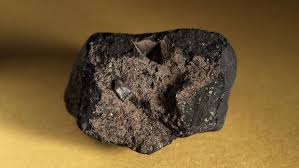Material collected from Tagish Lake meteorite that fell across Yukon, B.C. in 2000
Source: CBC News
On Jan. 18, 2000, a fireball lit up the morning sky over Yukon and northern British Columbia. Loud bangs shook the area, and dust clouds wafted in the upper atmosphere.
The culprit: a five-metre rock that entered Earth’s atmosphere. While most of the roughly 105-tonne meteor broke up on entry, some fragments showered down to the frozen landscape, much of it on Tagish Lake, B.C.
Fortunately for astronomers, with the lake being frozen, many of the fragments were able to be collected.
Now, a fragment of the meteorite from the Royal Ontario Museum’s collection may be shedding some light on how life could have been brought to Earth. (The museum has the most diverse collection of meteorites in Canada.)
While astronomers know that there was a lot of water in the early solar system, they have very little understanding of its chemical composition and specifically, how it led to the creation of amino acids, essential building blocks of life.
A new study published in the journal Proceedings of the National Academy of Sciences suggests the meteorite was sodium-rich, with high pH conditions, a potentially ideal environment for the formation of these amino acids. If the early solar system contained similar compositions, it may have helped trigger the development of microbial life on Earth.
Researchers from the Royal Ontario Museum in Toronto and McMaster University in Hamilton used an instrument that can image atoms in 3D. Using the atom tomography method, scientists were able to peer into the tiny raspberry-like grains of magnetite called framboids inside the Tagish Lake meteorite. They were able to see down to the atoms.

A ‘weird’ rock
Studying meteorites is the best way we have to understand the formation of our early solar system and life itself. That’s because anything deposited on Earth would have succumbed to things, such as weathering from water and geological activity, erasing the earliest history of our planet’s formation. That’s why the Tagish Lake meteorite — believed to have come from a larger asteroid — is considered to be such a gold mine of information.
“Amino acids, as we know them, are the building blocks of life,” said Lee White, lead author of the study. “Understanding the origin of water on these asteroids would allow us to say a lot more about the origin of water on Earth and … about [it being] implicitly tied into the origin of life: how amino acids could have formed, how microbes could have formed and eventually, how we could have formed.”

Chris Herd, a professor at the University of Alberta who has studied the Tagish Lake meteorite but who was not involved in the study, said the findings are important and particularly, the method that was used in the research.
“What is so amazing about it is that we end up getting that picture from this particular meteorite,” said Herd. “It’s probing the geology in more detail than we normally think of being able to do with meteorites.”
The Tagish Lake meteorite is one of the best-known meteorites to have fallen, partly because of how unique it is. The meteorite is a carbonaceous chondrite, a type of stony meteorite that represents about four per cent of all meteorites collected on Earth.
“Tagish Lake is such a weird rock. It’s the most weird rock ever,” said Kim Tait, curator of mineralogy at the Royal Ontario Museum and co-author of the paper.
“It actually changes its weight throughout the year. You can see the weight change through the summer because it’s absorbing water, and it’s [so] porous I could crush it in my hand because it’s a very light, fluffy weird rock.”
‘Rock that keeps on giving’
The researchers are also looking forward to the upcoming collection of material from the asteroid Bennu, around which the OSIRIS-REx spacecraft is orbiting. It is scheduled to scoop up rock samples from the asteroid in August and return it to Earth in 2023. Because Canada has an instrument on board called the OSIRIS-REx Laser Altimeter, some material will be given to researchers here. And it, too, might provide another piece of the puzzle.
But for now, the Tagish Lake meteorite is “the rock that keeps on giving,” Tait said.
“It’s sort of a time capsule of a rock from the very, very beginnings of the solar system over 4.5 billion years ago, and it hasn’t changed. It’s been completely untouched. And it’s come to Earth, and it’s giving us sort of a puzzle piece about some of the things that might have happened in the very beginning of the solar system.”
“I don’t think this story’s over, and I think there’s a lot more that certainly this rock can tell.”
Source: CBC News

































Leave a Comment
You must be logged in to post a comment.